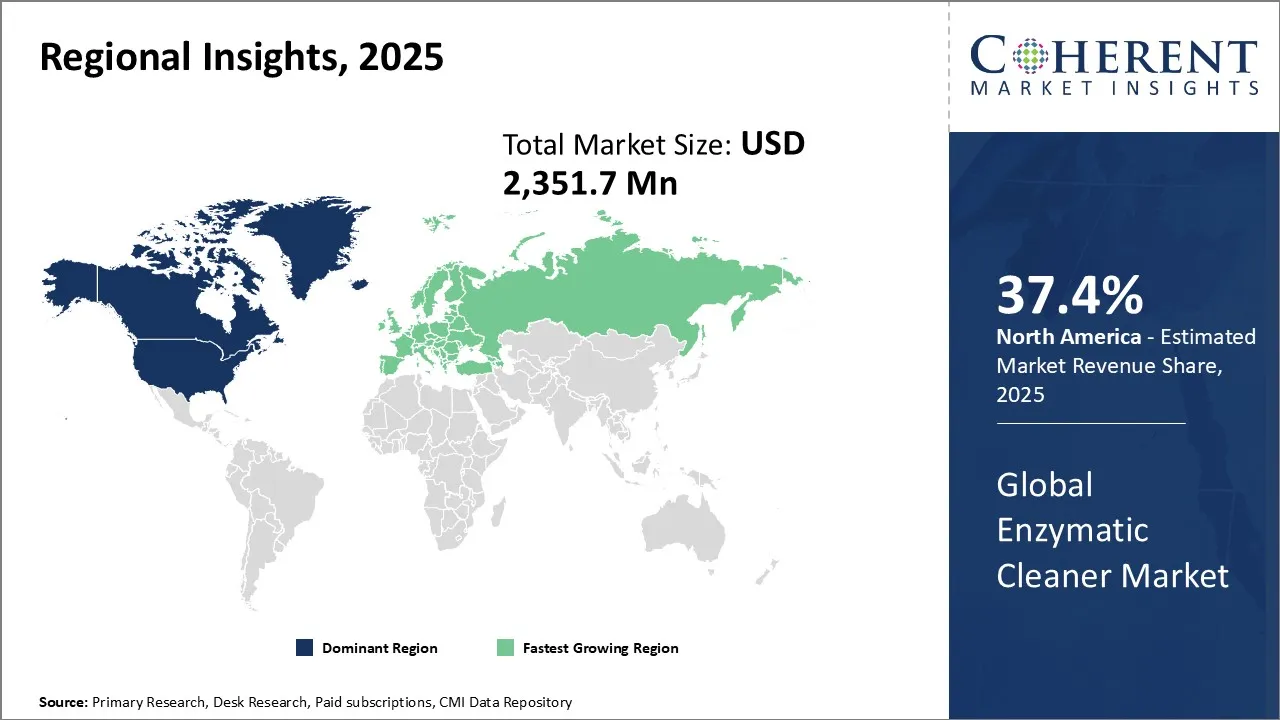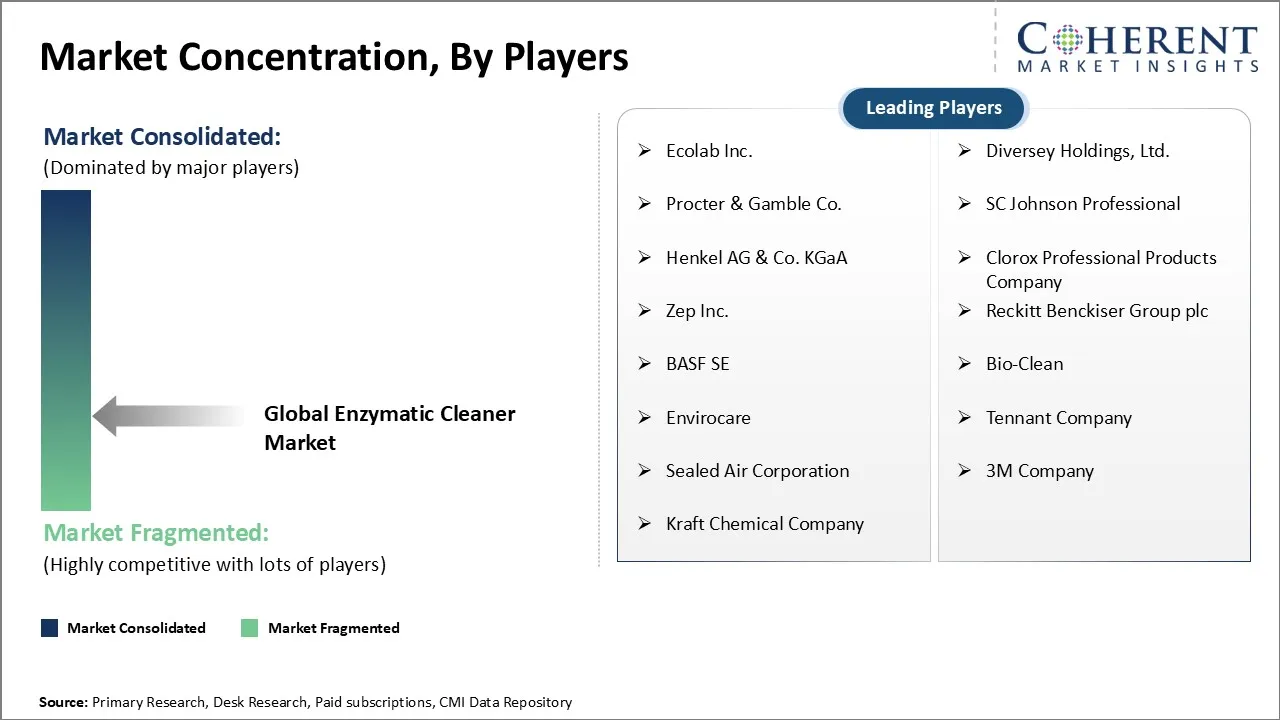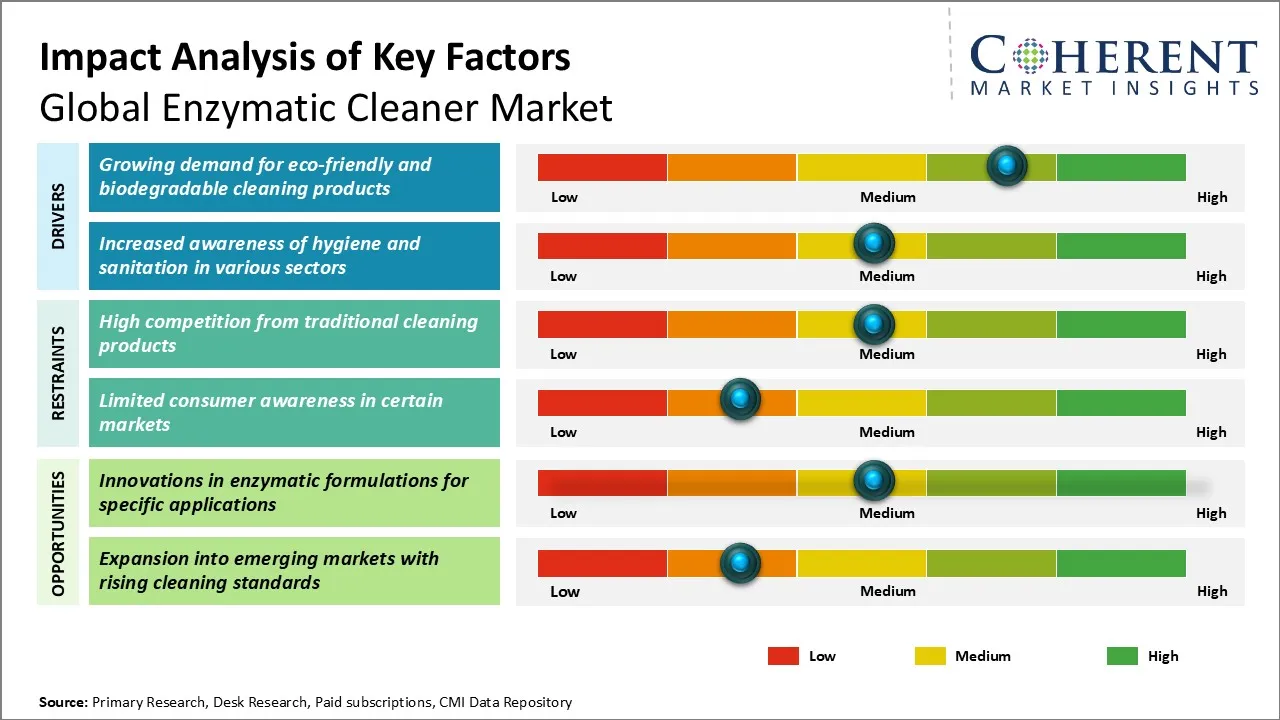The Global Enzymatic Cleaner Market is estimated to be valued at USD 2,351.7 Mn in 2025 and is expected to reach USD 4,354.5 Mn by 2032, exhibiting a compound annual growth rate (CAGR) of 9.2% from 2025 to 2032.
The market trend is characterized by a rising preference for eco-friendly and sustainable cleaning solutions, which enzymatic cleaners effectively support due to their biodegradability and non-toxic nature. Innovations in enzyme formulations and expanding applications in healthcare, food processing, household cleaners, and other sectors are further propelling market growth. Additionally, increased consumer awareness about hygiene and sustainable living, along with stringent regulations on chemical-based cleaners, are driving the shift towards enzymatic cleaning products globally.
|
Current Events |
Description and its impact |
|
Growing Environmental Regulations and Sustainability Drive |
|
|
Rising Health Awareness and Safety Concerns |
|
Uncover macros and micros vetted on 75+ parameters: Get instant access to report
The liquid segment is projected to contribute 55.9% of the market share in 2025, driven by its superior versatility and ease of application. Liquid enzymatic cleaners offer enhanced solubility and dispersion of enzymes, ensuring uniform distribution across various surfaces or integration into industrial cleaning processes. This characteristic facilitates efficient enzyme contact with organic soils, accelerating the breakdown of stains, grease, and other residues. The liquid segment is expected to grow at a robust 8.8% CAGR, further reinforcing its dominance in the market.
Proteases segment leads the market, contributing an estimated 45.6% share in 2025, driven by their broad-spectrum protein degradation capabilities and wide applicability. The proteases segment is expected to exhibit a robust 11.2% CAGR, reflecting the increasing demand for these enzymes. Their proteolytic action makes them indispensable in treating various organic contaminants such as blood, food particles, and bodily fluids, positioning them as essential components within numerous cleaning formulations. The widespread use of proteases is especially prominent in medical, laundry, and food industry cleaning applications where proteinaceous soils are common.
The microbial segment is expected to capture 39.8% of the market share in 2025, driven by their scalability, cost-effectiveness, and superior performance profiles. The segment is expected to register a 7.6% CAGR, reflecting its continued dominance. Microbial-derived enzymes represent the primary source of enzymes used in enzymatic cleaners, credited with several inherent advantages over animal- and plant-based counterparts. The capacity for large-scale production through fermentation technology positions microbial enzymes as economically viable and readily available. This scalability ensures a stable supply chain essential for meeting global demand across various sectors.

To learn more about this report, Download Free Sample
The North America region is projected to lead the market with a 37.4% share in 2025, driven by a mature industrial ecosystem and strong consumer awareness around sustainable cleaning solutions. The region benefits from stringent environmental regulations and supportive government policies promoting eco-friendly products, which foster the adoption of enzymatic cleaners across healthcare, food processing, and household sectors.
The presence of major industry players such as Ecolab Inc., Novozymes A/S (through its North American operations), and Diversey Inc. further propels the market development by advancing innovative enzymatic formulations and distribution networks. Additionally, North America's well-established R&D infrastructure and trade openness facilitate rapid product innovation and accessibility, solidifying its leadership status.
Europe region is expected to exhibit the fastest growth in the market contributing 30.2% share in 2025, fueled by advancements in green technology, strict environmental regulations, and increasing consumer awareness of sustainability and hygiene. Key industries such as food & beverages, pharmaceuticals, and cleaning services are adopting environmentally safe and efficient cleaning agents.
The European Union's commitment to sustainability, coupled with stringent regulations on chemicals and waste management, is driving demand for eco-friendly enzymatic cleaners. Key market contributors such as Novozymes, Chr. Hansen, and local players like DSM and BASF are expanding their presence in the region, innovating localized enzymatic solutions to cater to diverse applications in this highly regulated and environmentally conscious market.
The U.S. enzymatic cleaner market displays 12.1% CAGR, driven by strong demand across healthcare, food safety, and institutional sectors. Key players such as Ecolab and Diversey leverage advanced enzyme technology to produce highly effective and sustainable cleaning products. Government regulations like the EPA’s Safer Choice program encourage adoption of green cleaning solutions, further boosting market growth. The presence of robust supply chains and consumer preference towards eco-friendly products continue to shape the market dynamics.
China’s enzymatic cleaner market is characterized by rapid growth tied to expanding industrial sectors and increasing environmental consciousness, with a projected 8.8% CAGR. Local manufacturers, along with global companies such as Novozymes and Chr. Hansen, focus on adapting enzymatic cleaners to specific regional needs, including textile and food processing industries. Government policies supporting green chemistry and cleaner production practices significantly enhance market development, supported by rising domestic R&D capabilities and international trade engagements that facilitate technology transfer.
Germany continues to lead in Europe due to its strong industrial base and rigorous environmental standards encouraging innovation in enzymatic cleaning formulations, with a projected 9.1% CAGR. The presence of global giants like BASF and specialty enzyme suppliers supports a sophisticated market with tailored solutions for the automotive, pharmaceuticals, and food sectors. Government incentives for sustainability and stringent waste management norms enhance the demand for enzymatic cleaners, ensuring steady market advancement.
The U.K. enzymatic cleaner market is expanding rapidly, propelled by growing urbanization and heightened awareness of health and sanitation, with a projected 9.1% CAGR. Government initiatives promoting sustainability and eco-friendly products, along with stringent environmental regulations, offer fertile ground for market growth. Multinational firms, along with emerging local companies, are investing in enzyme technology tailored for both industrial and household applications.
The increasing penetration of organized retail and e-commerce channels improves accessibility and accelerates consumer adoption. Key players like Novozymes are contributing significantly to the market by innovating advanced enzymatic formulations for various cleaning applications, driving both industrial and household demand.
Japan’s enzymatic cleaner market reflects a mature demand for high-performance enzymatic cleaners driven by a combination of stringent hygiene standards and environmental sustainability commitments. Strong presence of companies like Ajinomoto and Kao Corporation with dedicated enzyme research centers fosters constant innovation. The country's trade openness and advanced manufacturing infrastructure support widespread use across healthcare, electronics, and food industries, maintaining its significant share in the global enzymatic cleaner arena.
Many industrial and commercial users—particularly in food processing and healthcare—express strong satisfaction with the eco-friendly and non-toxic nature of enzymatic cleaners. For example, a large food manufacturing facility reported enhanced cleaning efficiency and improved compliance with stringent hygiene regulations using multi-enzyme formulations that effectively break down organic residues and biofilms without damaging sensitive equipment surfaces. This has led to safer work environments and reduced chemical exposure risks for employees.
Conversely, frequent concerns arise around the higher cost of enzymatic cleaners compared to traditional chemical alternatives. Small- and medium-sized enterprises often cite price sensitivity constraints, limiting their ability to fully transition despite recognizing benefits. Another recurrent issue pertains to enzyme stability and variable performance, where end-users face inconsistent product efficacy due to environmental factors like pH, temperature, and shelf-life degradation. This instability complicates logistics, storage, and end-use reliability, particularly in regions with challenging climates or limited cold-chain infrastructure.

To learn more about this report, Download Free Sample
| Report Coverage | Details | ||
|---|---|---|---|
| Base Year: | 2024 | Market Size in 2025: | USD 2,351.7 Mn |
| Historical Data for: | 2020 To 2024 | Forecast Period: | 2025 To 2032 |
| Forecast Period 2025 to 2032 CAGR: | 9.2% | 2032 Value Projection: | USD 4,354.5 Mn |
| Geographies covered: |
|
||
| Segments covered: |
|
||
| Companies covered: |
Ecolab Inc., Diversey Holdings, Ltd., Procter & Gamble Co., SC Johnson Professional, Henkel AG & Co. KGaA, Clorox Professional Products Company, Zep Inc., Reckitt Benckiser Group plc, BASF SE, Bio-Clean, Envirocare, Tennant Company, Sealed Air Corporation, 3M Company, and Kraft Chemical Company |
||
| Growth Drivers: |
|
||
| Restraints & Challenges: |
|
||
Uncover macros and micros vetted on 75+ parameters: Get instant access to report

To learn more about this report, Download Free Sample
The increasing consumer awareness regarding environmental sustainability has significantly driven the demand for eco-friendly and biodegradable cleaning products, directly benefiting the enzymatic cleaner market. Traditional cleaning agents often contain harsh chemicals that pose risks to aquatic life and contribute to pollution, heightening concerns among environmentally conscious consumers and regulatory bodies. Enzymatic cleaners, derived from natural enzymes, offer a safer alternative by breaking down organic stains and waste without releasing harmful residues.
For example, as consumers become increasingly aware of the environmental impact of cleaning products, brands like Seventh Generation have shifted to plant-based cleaning solutions, which align with eco-conscious values. Their enzymatic cleaners, free of harsh chemicals, help reduce pollution while maintaining cleaning efficacy.
The global enzymatic cleaner market presents significant growth potential driven by continuous innovations in enzymatic formulations tailored for specific applications. These advancements are enabling manufacturers to develop highly specialized enzyme blends that target distinct contaminants, thereby enhancing cleaning efficiency across diverse sectors such as healthcare, food processing, industrial maintenance, and household cleaning.
For example, Novozymes, a leading producer of industrial enzymes, has pioneered enzymatic solutions for the food industry that focus on breaking down specific food-related contaminants, such as grease and starch in food processing plants. These formulations not only improve cleaning performance but also reduce the need for harsh chemicals that may leave harmful residues on food contact surfaces.
Share
Share
About Author
Sakshi Suryawanshi is a Research Consultant with 6 years of extensive experience in market research and consulting. She is proficient in market estimation, competitive analysis, and patent analysis. Sakshi excels in identifying market trends and evaluating competitive landscapes to provide actionable insights that drive strategic decision-making. Her expertise helps businesses navigate complex market dynamics and achieve their objectives effectively.
Missing comfort of reading report in your local language? Find your preferred language :
Transform your Strategy with Exclusive Trending Reports :
Frequently Asked Questions
Joining thousands of companies around the world committed to making the Excellent Business Solutions.
View All Our Clients